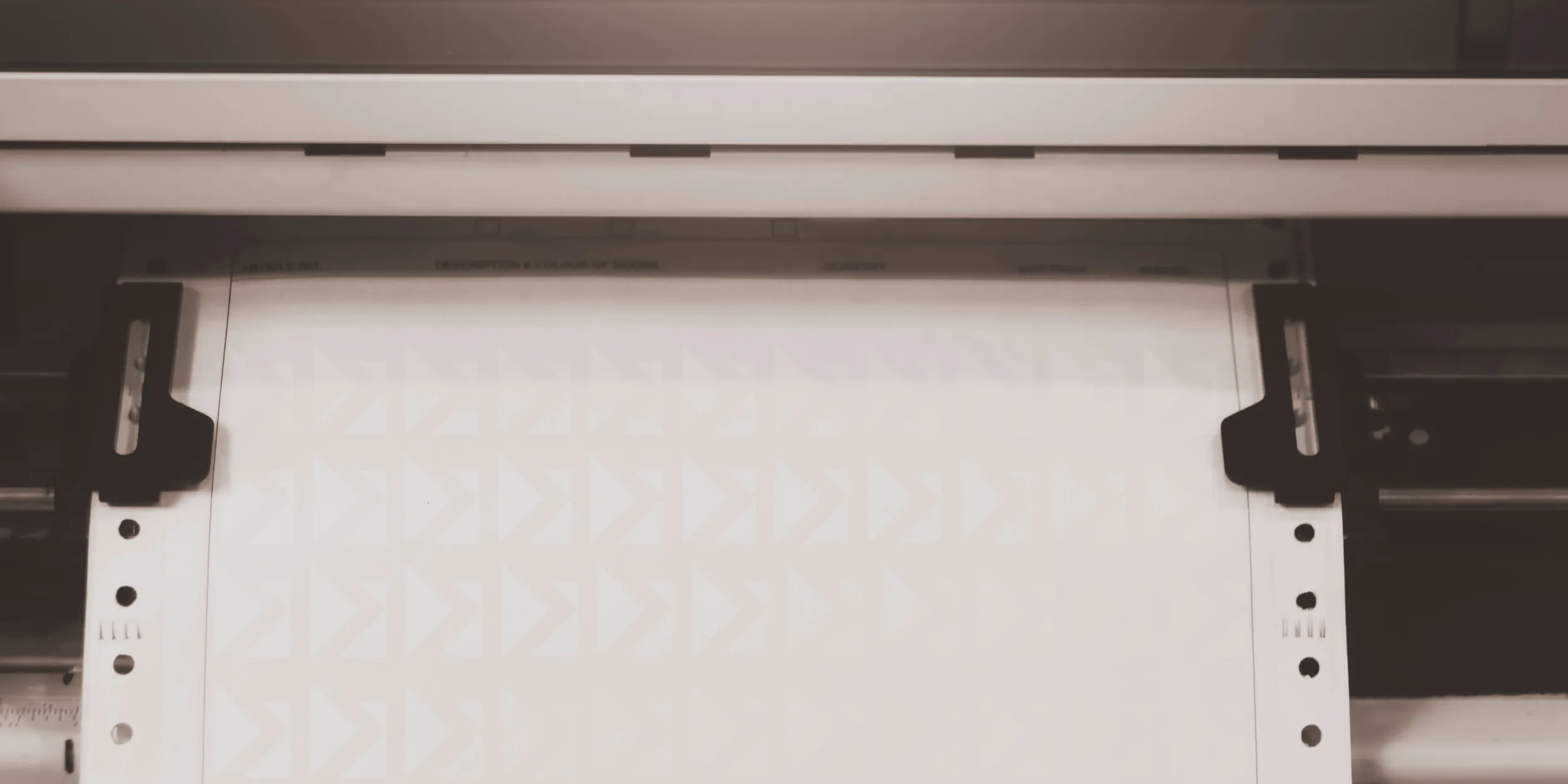What Is a Dot Matrix Printer? And Why Was It a Big Deal?
A dot matrix printer is a type of impact printer that uses a series of pins striking an ink-soaked ribbon to form letters and images on paper. Think of it as a cross between a typewriter and a computer printer. This technology, introduced in the early 1970s by Centronics, quickly became the backbone of business printing across industries.
From accounting and logistics to retail and healthcare, dot matrix printers dominated due to their durability, multipart form compatibility, and relatively low operating costs. At their peak in the mid-1980s, they accounted for more than 50% of printers used in U.S. businesses.
How Dot Matrix Printers Worked: The Technical Breakdown
Understanding the inner workings of dot matrix technology gives us insight into how far print solutions have come. These devices operated with either 9-pin or 24-pin print heads:
- 9-pin: Faster but lower resolution, ideal for basic text
- 24-pin: Slower but capable of clearer graphics and letter forms
They used continuous-form paper (often with perforated edges) and tractor-feed systems, making them perfect for:
- Printing carbon-copy forms
- Invoice runs
- Label printing in supply chains
Common print speeds ranged from 240 to 600 characters per second, with some industrial models capable of more.
However, they were noisy, required frequent ribbon replacements, and offered limited graphical capability, making them less suited for client-facing outputs or image-heavy documents.
Why Dot Matrix Printers Rose to Power: Context from the 1970s to 1990s
1. The Business Need for Multipart Forms
Before digital forms and email, businesses needed triplicate documents for invoicing, logistics, and receipts. Dot matrix printers could generate these in a single pass, something laser printers still can’t do.
2. Compatibility with Early Computers
Using simple protocols like ESC/P (Epson Standard Code for Printers), dot matrix printers were plug-and-play for early IBM PCs and mainframes. That simplicity made them universal.
3. Cost-Efficiency
Toner was expensive in the early days of laser printing. Dot matrix ribbons were dirt-cheap and easy to replace. For budget-conscious businesses, it was an easy choice.
4. Durability and Lifespan
These machines could run for tens of thousands of hours, often outlasting the systems they were connected to. The long mean time between failures (MTBF) made them the reliability kings of their era.
Why Dot Matrix Printers Declined: Technology Caught Up (and Surpassed)
By the late 1990s, laser and inkjet technologies had closed the cost gap while offering significant performance advantages:
1. Noise Pollution in the Office
Dot matrix printers were loud. As open offices became more common, this was a major drawback.
2. Print Quality Expectations Changed
The world moved from simple text to presentations, branded reports, and polished proposals. Dot matrix couldn’t deliver the resolution needed for these modern demands.
3. Incompatibility with Modern Systems
Modern operating systems and network environments phased out support for legacy ports and print protocols, making integration difficult without clunky workarounds.
4. Security Vulnerabilities
Dot matrix printers lack encryption, audit trails, and secure erase features. That’s a major issue in the age of data privacy, ransomware, and compliance standards.
Who Still Uses Dot Matrix Printers in 2025?
There are niche industries and legacy systems still holding on:
- Airlines printing gate tickets and luggage tags
- Government departments with outdated software
- Warehouses using dot matrix for industrial label printing
However, the risks of doing so are growing:
- Ribbons and parts are increasingly scarce
- Vendors are sunsetting support
- Every use introduces security and compliance gaps
If you’re still using dot matrix printers, the writing’s on the wall.
The Real Costs of Hanging On: TCO, Security, and Lost Efficiency
Let’s look at a 5-year Total Cost of Ownership (TCO) comparison between a legacy dot matrix device and a modern A4 multifunction printer:
| Feature | Dot Matrix | Lexmark A4 MFP |
|---|---|---|
| Print Quality | Low | High (1200 dpi+) |
| Noise Level | 50-60 dB | < 30 dB (quiet mode) |
| Multipart Form Support | Yes | Obsolete (digital forms instead) |
| Network Integration | Difficult | Plug-and-play, mobile-ready |
| Security | None | Encrypted print, secure boot, SNMPv3【11†source】 |
| Maintenance Cost | Rising | Predictable under MPS |
| Sustainability | Poor | Energy Star certified, duplex printing |
The numbers make it clear: holding on to dot matrix devices is costing more than money—it’s costing time, security, and professionalism.
A Psychological Shift: Why Businesses Struggle to Let Go
Technology inertia is real. From an emotional perspective, buyers often cling to what “works,” fearing the unknown or overestimating the cost and complexity of upgrading.
But here’s what the best companies do differently:
- They align tech upgrades with strategic outcomes, not just equipment replacement.
- They educate themselves and their teams.
- They lean on trusted experts, like Doceo, to guide the transition.
This is exactly where books like “They Ask, You Answer” and “Hack the Buyer Brain” intersect: your buyers want to be taught, not sold. This blog exists to empower them to make the call confidently.
What Should You Replace Your Dot Matrix Printer With?
✅ Lexmark A4 Multifunction Devices
Best for: Offices replacing single-function legacy devices with compact, modern solutions.
Features:
- Print, copy, scan, fax
- Secure pull printing and user authentication
- Mobile/cloud print ready
- Ideal for environments moving from multipart forms to digital workflows
✅ Toshiba or Epson A3 Systems
Best for: Departments needing larger format printing, finishing, or color fidelity.
Features:
- High-volume duty cycles
- Wide-format capability
- Workflow automation and finishing tools
At Doceo, we help you choose based on your workflows, not just specs.
Modern Scenario: What If Your Business Still Relies on Dot Matrix?
Imagine a mid-sized warehousing and logistics company with 75 employees. They’re using four dot matrix printers for packing lists, inventory reports, and delivery confirmations. The systems work—mostly. But here’s what’s happening behind the scenes:
- Supply chain delays for ribbon replacements
- Noise complaints from staff on the shipping floor
- Compatibility issues after a recent Windows update
- Security audits flagging print devices with no encryption or authentication
The leadership team knows the system is outdated, but fears disrupting a working process. That’s when they call in Doceo.
The Proposed Solution:
- Replace dot matrix units with Lexmark A4 MFPs
- Digitize multipart forms using cloud workflows and secure scanning
- Train staff with a simple rollout plan
- Integrate new printers into an MPS contract with full support
The Result:
- Quieter, more efficient operations
- No more lost forms or alignment issues
- Reduced IT involvement thanks to proactive monitoring
- A clearer picture of print usage and budget
While this is a fictional scenario, it mirrors real stories we hear every month. The lesson? The leap isn’t as big as it seems—and the payoff is huge.
Ready to Move Forward? Here’s Your Next Step.
If you’re still using dot matrix printers, your business is likely:
- Overspending on outdated supplies
- Risking security and compliance gaps
- Missing efficiency and integration benefits
Let’s fix that.
✅ Schedule a free Legacy Hardware Audit with Doceo. We’ll assess your fleet, identify risks, and show you cost-saving alternatives. Zero obligation.
Call: 888-757-6626
Visit: https://www.mydoceo.com
Locations: View All
LinkedIn: Follow Us
Doceo
Proven Technology. Proven People.





